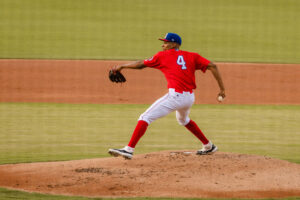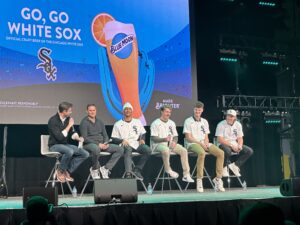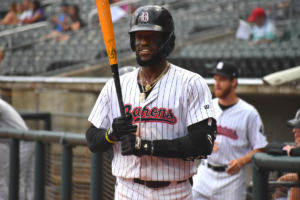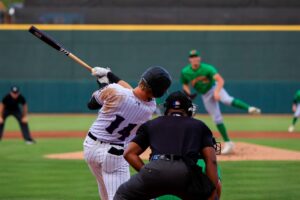Top 30 Prospects Q&A Mail Bag
Biannually, FutureSox releases a list of the top prospects in the White Sox system: once prior to the season starting and once after the MLB Draft. This is a group effort where all of our writers rank and offer different viewpoints on the prospects on the farm. This time around, we wanted to share some context and give a look into they way we came to our conclusions. So we went to Twitter to and sourced questions from our fans and readers and had our writers come up with the answers.
1) Which player has the best chance to make a huge leap in the rankings by this time next year?

Daniel Shapiro: The answer to this is Hickman – both Blake and Mike. Both (unrelated) Hickman’s made our honorable mentions list for reasons that could see the shoot up draft boards.
Blake is the most likely to leap in rankings. After slipping from the 3rd to 7th round in the 2015 MLB Draft, Blake discovered he had torn his UCL upon signing with the White Sox. It was a surprise to him as he had simply pitched through the discomfort towards the end of his junior season. Blake pairs a slider with a mid-90s fastball, so here’s hoping the White Sox medical and pitching staffs can help the hometown kid return to form. If he is completely healthy by the beginning of next year, he could easily jump from unranked into the high teens.
Mike is a different story. Mike was also drafted in 2015, but didn’t sign and went to Chipola College in Florida. He got drafted by the Sox again – going from the 36th round in 2015 to the 13th in 2016. Hickman’s got good athleticism, bat speed and lots of power potential. He’s played sparingly this season, but being so young has plenty of time to start shooting up the rankings once he reaches full-season ball.
2) What about Nick Delmonico, why didn’t he make it? Same for Hayes, another similar role in Charlotte?

Daniel Shapiro: Here’s a two part question that is answered quickly in regards to both.
Nick Delmonico has been disappointing since reaching AAA. After a stellar start to the season that saw Delmonico sport a .338 batting average and .397 OBP in AA, both numbers spiraled to .216 and .289 respectively in AAA. In short, it looks like the 23-year-old is getting overwhelmed in Charlotte. He could easily bounce back this year, but after barely making the Preseason List, his AAA results haven’t been up to snuff.
As for Hayes, he was abysmal to start the year but then quickly turned it around before settling in around his career average. Hayes has shown off power this year and can take a walk, but the main reason he missed the rankings this go-around is many don’t see him as much more than a backup first baseman in addition to being out for the last month and a half due to injury. If Hayes comes back healthy this season, he can likely get a September call-up and we can all get a better collective look at him.
3.) If the rankings were re-done by highest ceilings, how would your top 3 look?

Rob Young: The player I would rank #1 based upon ceiling is a personal favorite of mine, RHP Alec Hansen. The 6’7” righty was a pre-season favorite to be the #1 overall pick, however, his control completely abandoned him during stretches of the season and he fell to the White Sox in the 2nd round. Thus far in his professional career, Hansen has overwhelmed rookie league hitters to the tune of 32 strikeouts and allowed only 8 hits over 20.2 innings. Most importantly for Hansen, he has only issued six walks. Hansen has an overpowering arsenal, throwing his fastball 94-97 with running life, a wicked mid-80’s slider with good tilt, an upper 70’s curve, and flashes of a competent changeup. If he completely masters his control, Hansen has the stuff and the upside of an true ace. Though I should caution that Hansen suddenly displaying above average control is extremely unlikely, we can dream right?
My #2 player based on highest ceiling is an easy choice, considering he is still the FutureSox top 10 despite having a career .220/.279/.341 batting line. Micker Adolfo is 6’3”, 200+ pounds and looks like he could play linebacker for the Chicago Bears just as easily as he could be patrolling a corner outfield spot for the White Sox. His size and strength give him legitimate 60-70 grade power potential, combined with a cannon of an arm, and good speed for a player his size. In our hypothetical world of judging only his ceiling, Adolfo hits 30-40 home runs, plays above average right field, and his powerful arm shuts down runners going from 1st-to-3rd or stretching singles into doubles.
Adam Engel was famously compared to Mike Trout for a body comp and you think I wouldn’t include him on this list? Not a chance. Engel is a certified freak athlete, displaying plus plus speed, excellent arm strength, and a frame (6’2’’, 210) that suggests he has untapped power. The only tool that is stopping Engel from being the everyday center fielder for the White Sox right now is his hit tool. Engel had never hit for a high average until he went to the Arizona Fall League in 2015. Engel went absolutely crazy over his 19 games in the desert, hitting .403/.523/.642 to earn the prestigious MVP honor. Expectations were high entering the 2016 season and it has been a roller coaster season for Engel, being demoted to Winston-Salem before being returned to Birmingham and eventually promoted to Charlotte. The AFL proves Engel can hit premium pitching, but the consistency is lacking. If he puts it all together, Engel has the ceiling of a potentially gold glove center fielder while using his otherworldly speed to be one of the most dangerous base stealers in the game.
4.) How about by highest floor?

Rob Young: Full disclosure, I am not giving FutureSox’s #1 ranked prospect Zack Collins enough credit. Collins could have easily been on the highest ceiling list, but instead of I will highlight him here. Collins was a prolific college slugger and was billed as the most advanced bat in the whole 2016 draft. Collins boasts a fantastic overall approach at the bat, complimented by a smooth swing and a strong core that produces above average bat speed. The only reason he was available to the Sox at #10 was concern he could not stick behind the plate as a catcher. No matter if he ends up playing defense behind the dish, or eventually becoming a 1B/DH, there is little doubt his bat will play at the major league level. Collins already has a .294/.400/.618 line at Winston-Salem, displaying the strong OBP skills and power as advertised. Collins was one of the safest picks in the 2016 draft and I expect him to put up strong offensive numbers throughout the system while he works on his defense.
Jason Coats has the unusual distinction of having no plus tools, but is just quietly solid in all aspects of the game. He had hit at every level, but not put up any eye-popping numbers that ever garnered him much attention. However, Coats started 2016 on fire, hitting .333/.389/.518 in Charlotte and earning his major league debut in June, only to play him sparingly behind the likes of Avisail Garcia and J.B. Shuck. Coats is now back with the Knights and it looks like he will have to wait for something drastic to happen for him to get a real shot at becoming a regular in the White Sox outfield.
Jake Peter is a manager’s best friend, as he can play nearly every position on a baseball field. Drafted as a position player by the White Sox in the 7th round of the 2014 draft (despite throwing 95 off the mound), the White Sox have since aggressively promoted Peter to Charlotte. He has struggled a bit at the AAA level, but had no problem with Birmingham as he hit .288/.363/.390 over 68 games there. Peter has consistently hit for average and drawn walks, including a successful Arizona Fall League appearance (.309/.391/.364) that was overshadowed by Adam Engel’s monster performance. Useful at the plate, Peter’s real value is in his aforementioned defensively capabilities. Peter has played every infield position and both corner outfield spots, as the Sox clearly view him as a super utility player on the big league club.
5.) Jameson Fisher vs Alex Call – why is Fisher ranked higher? Is Call being underrated?

Matt Cassidy: These weren’t names we expected to generate controversy, but a number of our readers feel Call clearly should be ranked higher. In fact some are saying he’s clearly top 10, and possibly even top 5, in the White Sox system. We had Fisher ranked 11th, and Call 15th. for comparison, Jim Callis of Baseball America put Fisher 8th and Call 19th on his list (which was published the same day as ours). So he was even more in on Fisher having an edge.
There are similarities here. They are both outfielders, though in Fisher’s case he’s new to that role. Both were drafted as college players with advanced plate approaches. What does Call bring that gives him an edge? He’s a true outfielder, and in fact has been playing mostly in center field so far as a pro, whereas Fisher is on the corners and new to the position. Call also grades out as an above average runner, where Fisher is below average on most ratings. And Fisher? By all accounts, Fisher has above average potential in hit and power (could be plus in the former), whereas Call grades out average-ish on Hit and below average on power.
It’s a close call, with counter-balancing tool grades. I think perhaps some folks are assigning far too much predictive value to Call’s red-hot pro start. Those numbers, mostly in rookie ball, have very limited value for a college player and should not be relied upon heavily. In the end, Fisher’s very strong hit tool and power potential eek out an edge for our writers as a group (though there were some differences among the staff). Anyone saying that either one is a clearly better prospect is probably over-simplifying. We’ll know a lot more in a year or so.
6.) Where would newly acquired prospect Charlie Tilson fall in the rankings if he were now included?

Matt Cassidy: It’s always tough to make this sort of call, when we can only rely on reports from others because we haven’t seen what he can do. Callis recently said he’d slot in at 5th on his White Sox list, though that seems high to me. He’s got elite speed and is said to handle center field competently or better. But frankly, that doesn’t seem a whole lot different than Jacob May or Adam Engel. He’s also got very little power projection. Where he does grade out higher than May or Engel though, is hit tool, at least with some evaluators. Having a toolsy outfield prospect who makes consistent contact is a nice asset for this system. But I think he’s more in the 9-11 range, and in fact I’d probably put him right around 10th in the current farm. The variance between my view and others’ really centers around the hit tool, so how that fares will be the deciding factor.
***The above was written before Tilson’s injury last night, but that likely won’t have any bearing on his ranking.
7.) Is Luis Curbelo too high at 7? What puts him there?

Brian Bilek: When going through our rankings, we often naturally fall into tiers in the way we stratify the prospects. This time around, that first tier was made up of five players with only a few exceptions. Namely: Collins, Fulmer, Adams, Burdi and Hansen were the group that made up that first tier. Starting at pick #6, the variability between our writers and their respective rankings ran rampant. The second tier of players was largely comprised of players who were in the top ten coming into the year and have under-performed, as well as some of the more exciting draft picks taken on Day 2 of the Rule 4 draft.
So why did our writers get excited enough about Curbelo to give him a ranking of 7th overall? Despite being picked in the 6th round, Curbelo signed the fifth highest bonus in a draft where the team had two first round picks. White Sox Scouting Director Nick Hostetler told us that the team was aware that Curbelo would slide further than his talent would place him in a more meritocratic drafting system. So having the leverage of being a high school draftee and a University of Miami commit, Curbelo’s bonus demands allowed the White Sox to add a top 100 draft prospect in the middle of Day 2.
While born in Puerto Rico, Curbelo was drafted out of Cocoa High School in Florida after moving there as a teenager. Keith Law had the sturdy shortstop listed as high as #48 on his big board. The reasons to be excited with Curbelo include the fact that he has good speed and projectable power at an up-the-middle position in shortstop. While his bigger frame (6′ 3″) will likely move him to 2B or 3B, Curbelo is still an offensive-oriented prospect regardless of the position he eventually calls home. As to whether he is ranked too high at pick #7, I’ll say he isn’t. While he hasn’t gotten off to a blazing start in his first stint in Rookie Ball in the Arizona League, it’s far too early to judge him off of this small pro sample. Given the players that sit adjacent to Curbelo in the rankings, you can hang your hat on the fact that Curbelo has a higher ceiling. This could be argued either way without exception, but I’ll buy into Curbelo’s profile juxtaposed to the immediate competition.
***If you enjoyed this article, please let us know and continue to send your questions our way.
Want to know right away when we publish a new article? Type your email address in the box and click the “create subscription” button. Our list is completely spam free, and you can opt out at any time.







I’m one of the Chicagoan’s who like both baseball teams. Each year I like one a little more than the other. It varies year to year. I am a big fan of the minor leagues which is why I enjoy this blog so much. It’s really a great blog by the way. But I am getting so frustrated with the White Sox approach to minor league development because I can now compare it to a state-of-the-art organization across town. The Sox don’t seem to have a clue about development. Taking a player and working on the weak spots in his game while learning an organizational philosophy on how to play the right way. Frustration #2 is always wanting to promote players quicker than they should only to get a half-developed player to the majors so he never hits anywhere near his ceiling(Rodon and now Fullmer, and Anderson. The players seem like they are left alone to figure things out while never figuring things out is not a reason for more development or time. Guys that have figured things out and lack a huge hole in their game like Coats are ignored. Why isn’t he being played to see what they’ve got there? I would love for the Sox to clean house, not player-wise but managerial-wise. Hire the Cubs director of their minor league system Jason McLeod as president(sorry Kenny but it’s time for a new direction). Let him completely rework their player development philosophy. A lot of heads would have to roll but that’s the price of mediocrity.